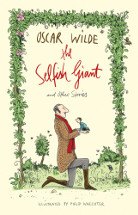The selfish giant by Oscar Wilde

Ill. by Ritva Voutila. Allen and Unwin, 2012. ISBN 978 1 74237 650
9.
(Age 8+) Highly recommended. Picture book. Fairy tale. Redemption.
Some books are simply a pleasure to pick up and hold, and this is
one. Beautifully bound, the cover illustration is redolent of the
northern European landscape, cold and dull, sun part hidden by the
shadowy clouds, the castle lacking any warmth. But one tree is
covered in blossom, standing out from the others which are bare in
the winter cold. And Voutila's illustrations capture the eye for the
rest of the book.
Oscar Wilde's fairy tales, published in 1888, contained five tales,
including The happy prince, the most well known of the
group. Each has a moral basis, and this one is no exception. Reading
it again, I was surprised at the Christian element as I had not
remembered that at all, but the story of a selfish man finally
giving over his garden to the children of the town is certainly one
of forgiveness and redemption.
The children gather each day in the giant's garden as it is full of
life. But the giant returns after a seven year absence, and puts a
no trespassing sign on his gate, forbidding all to enter. Cold sets
in and spring, summer and autumn never come to the garden again. The
giant is bereft, not understanding why the garden never changes,
until one day he helps a small boy with marks on his hand, climb a
tree. This encourages the other children to return and so the giant
is happy, offering his garden to all to visit. When he next sees the
small boy with the marks on his hands, he asks what they are. And
the boy replies they are the marks of love, and tells the giant he
will live with him in his garden in Paradise. And so the giant dies.
This lovely story will bring tears to the eyes of its readers, as
they absorb the selfishness of the man, and how this is repaid with
the cold until he relents and allows the children into his garden
and his life.
The beautiful illustrations are breathtaking, spreading across each
double page, bringing the art tradition and landscapes of northern
Europe into the classroom. The sepia tones hold the attention of all
who look inside the covers, the myriad of detail intriguing all who
read the story, the motifs repeated, insisting that the reader
thinks more closely about what is being represented. When the giant
relents, colour returns to the pages, and even in the cold of the
day he dies, there is life in the tree above him.
For classes looking at various fairy tales this is an exceptional
book to use, the text and illustrations dovetailing together. For
secondary classes this would be an entirely engrossing book to use
to allow older students to marvel at the link between text and
illustrations, or simply look at some fabulous illustrations and the
imagery presented.
Fran Knight